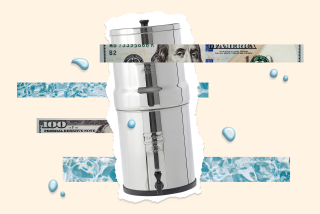Flush With Success : Engineer’s 69-Cent Invention Lessens Water Loss In Toilets
- Share via
IRVINE — With all the talk of drought and rationing and summer water bills rising like a geyser, Victor Wasbin figured it was time to dream up a better way to turn off the tap.
So he headed straight to the toilet.
The retired engineer concocted a 69-cent solution that he says converts any old water-wasting commode into a commendable facsimile of an ultramodern low-flush model.
In the process, Wasbin cut his own water bill by a third, got about 40 friends and neighbors to embrace the idea, and even had a local water official recommend that he patent it.
What has everyone in such a tizzy is an invention that Wasbin contends is “such a simple, stupid thing” that he would be ashamed to market it for fear “some of my friends would laugh at me.”
Instead, the 71-year-old inventor professes that his sole motivation is altruism and a nagging hope that his makeshift doodad find its way into toilet tanks of do-it-yourselfers up and down bone-dry California.
Here’s how it works.
When you hit the handle on a conventional toilet, a rubber flapper in the tank flips up and floats, allowing water to escape and start a whirlpool effect in the toilet bowl. That vortex of water whisks away the bad stuff. When the tank’s water level drops, the flapper flips back down and the tank refills. In all, five or six gallons are consumed by most older models.
“Up until now,” Wasbin explains, “everyone concentrated on making the flapper buoyant so it would let water flow out. I was working in the other direction.”
Wasbin simply attaches a small weight--about 1 1/2 ounces or so--to the flapper so it doesn’t float. As a result, one has to hold down the handle for three or four seconds to get the toilet to flush. But once the chain reaction is started, the handle can be released, saving lots of water that otherwise would flow needlessly down the drain.
As Wasbin figures it, an average person can conserve three or four gallons a flush by incorporating his concept into a toilet tank. And one hardly has to be a handyman to jury-rig such a system.
A jocular Russian immigrant who came to the United States after World War II because “I lost my direction and went west instead of east,” Wasbin has been tinkering for years on various inventions and gadgets.
He parked himself in his garage a few months back, flanked by a pegboard clustered with wrenches and screwdrivers and every other imaginable tool, to figure out how to reduce the water consumption of his Irvine home’s toilets.
“I’ve got nothing else to do but fool around in my garage, so I figured I might as well work on something that would contribute,” he says. “We’re going to dry up and blow away if we don’t do anything here.”
What he eventually came up with is painfully simple. A small, 3/4-inch-diameter brass nut is used as the weight. (He cautions against using steel because it can rust.) Wasbin slips off the chain linked to the toilet handle and slides the nut down to the flapper. He then cements the nut to the chain with water-resistant silicon glue.
“Any housewife can do it, except mine of course,” Wasbin chuckles, giving a wink at his wife, Pearl.
Operation of the device is just as easy. One has to be a certifiable dolt not to perfect the proper technique within a few flushes.
“After a while, you get a touch,” Wasbin noted, lifting the guest room toilet’s fuzzy cream-colored seat cover to demonstrate his skills. “Having to hold the lever for a few seconds is a small price to pay to save so much water.”
Eager to spread the news, Wasbin a few weeks ago put a note in his homeowner association’s monthly newsletter describing the invention. The result wasn’t quite hot cakes, but it wasn’t bad. Dozens of neighbors called to inquire just how he did it.
Most of the people managed on their own to convert their toilets to the Wasbin system. But the inventor also did the work for a number of others, including next-door neighbor Marie Walker.
“It’s a great idea,” Walker said. “You hold it down and count to four and that’s it. One, two, three, four, and it works fine. It takes a day and you’re used to it.”
But what do the water experts think?
Ron Brown, a senior analyst with the Metropolitan Water District, said Wasbin’s idea is just one of scores of water-saving devices that have surfaced during these days of drought.
“This one sounds like a good idea,” Brown said. “Some people would find it a viable method, others may prefer a toilet dam or taking a small plastic bottle and putting it at the bottom of the tank to save a gallon or so.”
Tom Holliman, a principal engineer at Irvine Ranch Water District, actually got a gander of Wasbin’s invention in action. He came away reasonably impressed, predicting it’s success will hinge on whether people are willing to stand by the toilet and hold down the crank.
“Instead of an automatic transmission, now you’ve got a four-speed,” he said.
Not everyone, however, is high on the Wasbin system.
John Shaw, executive director of the American Society of Plumbing Engineers, expressed concern it could reduce a toilet bowl’s water level, potentially causing sanitary problems.
“I would be very hesitant to endorse it,” said Shaw, who recommends installing one of the new, ultra-low-flush toilets instead. “For a full to large-size adult you may not have enough water in the bowl to function.”
Back in his garage, Wasbin is showing off the various types of flappers he has converted to his low-flush system. There are bright red ones, white ones, a whole host of black ones. Even the first one he perfected.
“This is my No. 1, patent pending,” he joked. “Made in Hong Kong.”
In all, Wasbin figures he spent about $71 on various flappers and nuts and glue to perfect his idea. In return for his labors, he has accepted no pay. A few neighbors have given him a cold beer. One even gave him a six pack.
But it’s been worth it. Now he hopes his idea will be passed on to other inhabitants of the drought-stricken West.
“If a million acre-feet of water are saved, I’ll be happy,” he concluded. “It’s not prudent to use so much water. It’s criminal. There’s no need.”
More to Read
Sign up for Essential California
The most important California stories and recommendations in your inbox every morning.
You may occasionally receive promotional content from the Los Angeles Times.













